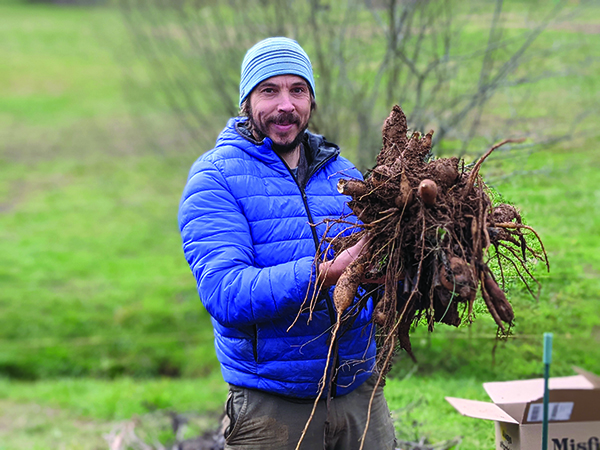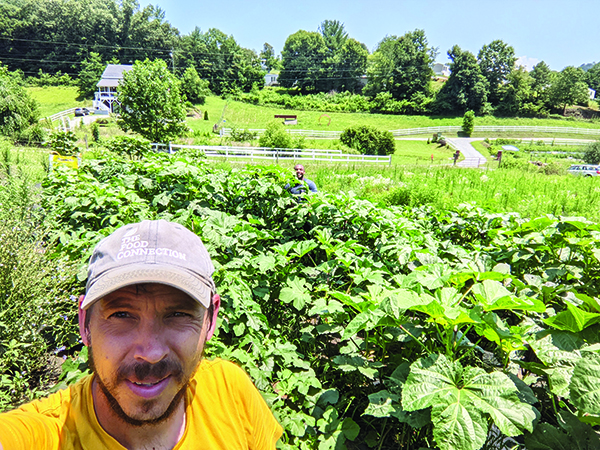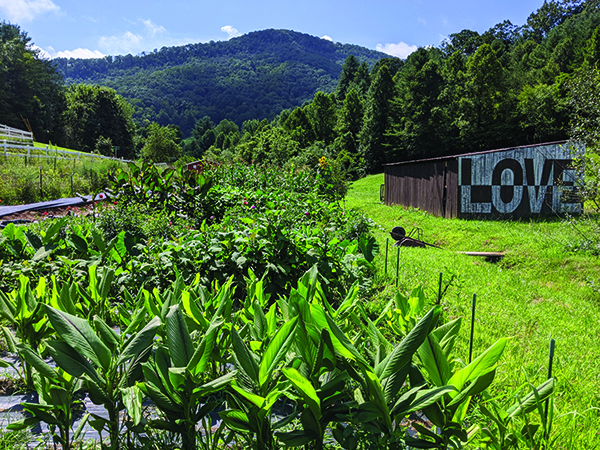Diverse genetics, migrating crops strengthen local food systems
The Utopian Seed Project is anticipating a less than utopian future as climate changes threaten crops and growing environments. Among the approaches the nonprofit is taking to fortify local food systems in the face of climate change is migrating crops north to adapt as warming temperatures move northward. The project, treating tropical perennials as temperate annuals, so far is succeeding with taro, chayote and other tropical crops imported to trial farms in Western North Carolina.
 Chris Smith holding a freshly harvested yacón (aka Bolivian Sunroot) root mass. Yacón is among the tropical plants they are bringing north to adapt to new climates. Photo courtesy of Utopian Seed Project.
Chris Smith holding a freshly harvested yacón (aka Bolivian Sunroot) root mass. Yacón is among the tropical plants they are bringing north to adapt to new climates. Photo courtesy of Utopian Seed Project.
Another strategy is to produce crops so dense with genetic possibilities that the plants can orient to a wide range of environmental stresses in different regions. While Growing for Market readers are quite familiar with heirloom crops and practices to protect their characteristics, the Utopian Seed Project is going in the opposite direction: spurring cross-pollination among scores of heirlooms and varieties to produce plants with many parents. A mosh pit of 85 Okra varieties in a parent population created the Okra Ultracross.
Utopian Ultracross Collard seeds are the result of crossing 21 distinct heirloom collards. The Utopian Seed Project collaborated with The Heirloom Collard Project (20 heirlooms), but then added “Lottie” collard, bringing the heirloom total to 21 for the Utopian Ultracross Collard.
“We’re basically taking all those fairly stagnant heirloom genes and shaking them up with a whole lot of other varieties,” said Chris Smith, a transplant from England who is executive director of the Utopian Seed Project. “Our aim is to maintain as much diversity as possible so that the plant population carries a high adaptive capacity and can respond quickly to environmental pressure like a warming climate or changes in pest and disease pressure.”
Melony Edwards of Ebony by Nature farm in Washington State dubbed these Utopian seeds “ultracrosses.” That’s not a technical breeding term, but it stuck. Other descriptors of mosaics of genetic diversity include: breeders mixes, grexes, and composite crosses. “Some people would describe the process as creating a landrace,” Chris said. “I prefer to save that term for plants that have been cultivated in place and community for a long time.”
Utopian’s work is strongly supported by Asheville-based Sow True Seed — Sow True’s founder Carol Koury backed the creation of the Utopian Seed Project five years ago — and Virginia-based Southern Exposure Seed Exchange (SESE). As a nonprofit, Utopian also is supported by grants, donations, seed contract work and other projects.
Farmers and gardeners buy seeds with origins in Utopian’s work from Sow True Seed and Southern Exposure Seed Exchange. Utopian’s trials are carried out at two experimental plots: the original, Franny’s Farm in Leicester, North Carolina; and the Southern Appalachian Highland Conservancy incubator farm in Alexander, North Carolina, a second site added in 2022. Both sites use no-till methods with low-inputs. Utopian also works closely with a network of farmers and growers.
Farmers who buy and grow out select ultracrosses can participate in Community Seed Selection (CSS) projects and receive guidance from Utopian and SESE. For instance, Utopian Ultracross Collards survived 8°F during the winter of 2020, then spring and summer of 2021 seeds were saved from the surviving plants. Since then, Utopian Ultracross Collards have survived 0°F in various places. So, the CSS collard project is building on that. A diverse group of farmers, separately but together, are engaging in the same seed selection goal.
 Utopian Seed Project executive director Chris Smith in the okra field with Jordan Collins in the background. They had 85 varieties in the parent population that led to the Okra Ultracross. Photo courtesy of Utopian Seed Project.
Utopian Seed Project executive director Chris Smith in the okra field with Jordan Collins in the background. They had 85 varieties in the parent population that led to the Okra Ultracross. Photo courtesy of Utopian Seed Project.
“Our objective is to save seeds from the most cold tolerant and tasty collards while preserving a wide diversity of types and colors,” Chris said. Of course, farmers planting ultras can selectively save seed for any criteria or not save seed.
Chris, a self-educated botanist and breeder, didn’t engage in serious farm work until he moved to the United States about 10 years ago. However, his brother is a horticulturist and his mother a serious gardener who together started a seed company in the United Kingdom. A job in marketing and community outreach at Sow True Seed set Chris on the path. Sow True specializes in open-pollinated seed varieties which gave Chris a lot of experience with heirlooms. That exposure ultimately sent him in another direction searching for climate resilient crops.
Chris was on the board of The People’s Seed, created with a mission to create regional seed sovereignty for food security, equity and protecting the environment. It’s founder was Tony Kleese, a farming activist and consultant who helped develop the USDA’s National Organic Standards in the 1990s and who died of cancer in 2018. Kleese created The People’s Seed to radically transform the seed industry. In 2020, Chris merged The People’s Seed into the Utopian Seed Project. Each year Utopian highlights breeders whose crop work strengthens local food systems with The Tony Kleese Award.
Chris’ marriage to a Southerner propelled him into an intense relationship with okra. Chris’ book, The Whole Okra: A Seed to Stem Celebration, won a 2020 James Beard Award for History, Research and Scholarship and links him indelibly with the plant. The book is an absorbing, charming read packed with details for plant geeks and chefs. His writing and editorial skills come into play with Crop Stories, a magazine the Utopian Seed Project took over and that Chris co-edits.
Published once a year, Crop Stories embraces a single crop with essays, recipes, art and poetry. The most recent issue features collards and the upcoming topic is Southern peas. Past issues covered sweet potatoes, greens, radishes, winter squash and blueberries. A Crop Stories podcast is slated for next year.
Utopian Seed Project is engaged in many other projects. Among them: a Sow True Seeds contract producing sesame seeds from seedstock originating from Thomas Jefferson’s Monticello sesame plants; a collaboration with Seed Savers Exchange and a community of farmers to resurrect a nearly lost mid-1800s heirloom variety of okra, Whidby White; an edible dahlia tuber project; teaming up with chefs to bring regionally unfamiliar food crops into the public consciousness and build consumer demand in a series of Trial to Table culinary events.
The Whidby White heirloom resurrection project is a yin to the ultracross yang. “Whidby White is an example of a more classic form of seed saving,” Chris said, “selection towards a specific ‘distinct, uniform and stable’ variety.”
They also established a Western North Carolina Seed Growers Collective so farmers can save and share seeds suited to the region. Utopian’s mobile seed processing trailer makes equipment such as a seed cleaner available to help farmers scale up seed growing. It’s a model that could be replicated elsewhere.
The remainder of the article expands on the projects mentioned at the outset in a Q&A format with Chris.
How are ultracrosses created?
“The basic process is very simple, we plant a broad range of good quality varieties together and instead of worrying about preventing cross-pollination, we encourage it. Some things like collards are obligate out-crossers — they literally have to out-cross — and so they’re easy. Okra is somewhere in the middle with some level of natural crossing but also a tendency to self [pollinate]. We interplant varieties and have high pollinator activity on our farm. For things like Southern peas, which are heavily selfing, we have been selecting for peas with a more promiscuous nature to try and steer the population towards an outcrossing nature.
 Utopian Seed Project trial fields at Franny’s Farm in Leicester, North Carolina. Photo courtesy of Utopian Seed Project.
Utopian Seed Project trial fields at Franny’s Farm in Leicester, North Carolina. Photo courtesy of Utopian Seed Project.
“The fun thing with the ultracross is you can use its potential anyway you want, either to adapt to a specific microclimate or a specific challenge or just to explore the beautiful varietal diversity that a mixed seed population offers. It will shift and change over time as you develop a relationship with the seeds and the seeds develop a relationship with you. The future direction of the ultracross is totally in the hands of the grower (or passively, the environment).
“At the ultracross stage every plant is different. [Utopian Ultracross Collards] have 21 parents and all those parents have completely intermixed. Every child and seed is going to be genetically unique — massive genetic diversity, the adaptive capacity is massive. Put them anywhere and within a numbers years, if you are making selections, you actively shift the population. Or environmental selection. We’ve been selecting for cold tolerance.
“Environmental selection conditions are becoming more chaotic, more erratic. The environment is shifting, and we need to have plants that quickly shift in response. Broad genetic diversity, a broad genetic intelligence, can shift quickly.
“Perceived downsides to the whole concept is that the food system demands uniform, stable varieties. There are those expectations even in farmers markets, farmers have expectations of what is going to happen in the fields. A lot of that is based on mechanized harvest. There’s strong inertia blocking change.”
Tropical perennials as temperate annuals
“If you’re willing to pay for heating and lighting then you can theoretically grow anything anywhere, but our aim is for field cultivation. This generally means that tropical fruit trees are not high on our list because we need to be able to produce something in a single season so we can carry some kind of propagation material over the winter.
“There’s a reason why we currently work with so many tropical root crops and that’s because dormant roots are the easiest thing to over-winter and sprout again the following year. We already do this with potatoes and sweet potatoes. We also work with stem cuttings like cassava. In the tropics folks will harvest cassava and then stick a section of stem right back in the ground. If we did this in Western North Carolina, those stems would die over the winter.
“We’re having a lot of success with taro (Colocasia esculenta), which actually had a pretty good survival rate with a last winter low of -1°F. I was pretty surprised when fresh growth popped back up late in the spring. One patch has perennialized for three years. At least some of the taro varieties could definitely be described as temperate perennials at this point. This year we have six variety trials.
“For those who don’t know, taro is a pretty ancient tropical food crop with deep culture across most of the tropics. All parts of the plant contain oxalates which can be broken down by cooking, the above ground leaves are edible and the primary crop is the underground corm, which can be eaten pretty much any way you eat potatoes. The great thing with taro is that it loves the heat and doesn’t yet have any pests or diseases.
“As the climate continues to warm, taro is likely to become an important food source. There’s no reason not to be growing it, but we don’t have a regional market yet. We work on demand for it.
“We also grow roselle, ube, chayote, moringa, aibika, yacón, ginger, turmeric — all in open field cultivation. Most of them do really well, but we do run into occasional challenges. Last year we grew winged beans and despite ample lush foliage covering a tall trellis, we never saw a single flower, let along winged bean. Similarly we’ve grown cassava for multiple years and the plants get large and look extremely healthy, but the root harvest is always disappointing. Everyone wants it, but we’re not getting decent production on it. I think it’s a variety thing, so we’re hunting out varieties.
“One thing we know with a lot of tropicals is that they are triggered to form flowers or roots at a certain day length and often we don’t get ‘short enough’ days until after our first frost. Dealing with this photoperiod challenge is really hard.”
Seeds bred where they are grown
“The ability of a plant to adapt to an environment is hugely understated. We adapt the environment to the plant with irrigation and pesticides. The plant has the ability to adapt to the environment and you have with less reliance on inputs.
“I think the importance and power of seeds are often underestimated and underappreciated. Seeds are living things that change over time, and plants react to their environments. Over multiple plant generations, seeds with enough diversity can shift and change in ways that suit the farmer and the environment where that farmer is growing.
“Unfortunately, most seeds are not produced in the areas where they are being grown. There is a large international seed trade as well as concentrated seed production regions in the USA. There is very little commercial seed production in the Southeast, and so Southeastern farmers rarely have access to seed that has experienced our unique set of growing challenges.
“The same holds true for conventional seeds not being adapted to organic conditions, and there is a serious lack of organic plant breeding in the USA. There’s not a lot tailored to no-till, no pesticides. So what farmers are buying on the market are not tailored the their environments.
“We have to be looking at the seed. Ask the questions about where the seed was grown, do more homework. You may already have a local seed company in your area, just be sure to ask who is growing the seeds and where.
“I think the core message is to reconnect with local seed (or regional) seed that has some level of diversity to allow for adaptation, or even just acknowledge how critical seeds are to the food system and begin deeper conversations about them. The deeper you go with seeds the more you realize their importance and potential.”
Can busy farmers save seeds?
“I think it’s unrealistic to ask all farmers to grow all of their own seed, but there are examples of some farmers being successful with saving one or two seed crops. Seeds are an important part of the [climate change] solutions, we need seeds that can deal with it. There are ways to do it that can make sense in farming systems. Crops are producing seeds anyway. If you have the ability, it is possible to save one or two seed crops for your own use. Incorporate a little on-farm seed saving. In one or two years you can see huge differences, that might be the hook.
“Look at the regional level shared within a farming collective. That’s not a high burden on any one farmer. We have recently launched a Western North Carolina Seed Growers Collective which is basically a group of farmers in western North Carolina who are each growing one or two regionally adapted seed varieties to share within the collective and then sell to regional farmers and gardeners. I think the regional collective model has a lot of power and potential for seed production.
“If farmers want to start saving seeds then there are lots of great resources out there. The Utopian Seed Project recently produced a short video series that could be a good place to get started at tinyurl.com/3cu8jnb3.”
Jane Tanner grew cut flowers and specialty crops at Windcrest Farm and Commonwealth Farms in North Carolina, and helped manage the biodynamic gardens at Spikenard Farm in Virginia.
